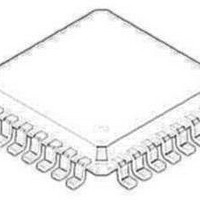NCP5331FTR2G ON Semiconductor, NCP5331FTR2G Datasheet - Page 24

NCP5331FTR2G
Manufacturer Part Number
NCP5331FTR2G
Description
IC CTLR PWM 2PH W/DRVRS 32-LQFP
Manufacturer
ON Semiconductor
Datasheet
1.NCP5331FTR2G.pdf
(36 pages)
Specifications of NCP5331FTR2G
Applications
Controller, AMD Athlon™
Voltage - Input
9 ~ 14 V
Number Of Outputs
2
Voltage - Output
5V
Operating Temperature
0°C ~ 70°C
Mounting Type
Surface Mount
Package / Case
32-LQFP
Mounting Style
SMD/SMT
Lead Free Status / RoHS Status
Lead free / RoHS Compliant
Other names
NCP5331FTR2G
NCP5331FTR2GOSTR
NCP5331FTR2GOSTR
Available stocks
Company
Part Number
Manufacturer
Quantity
Price
Company:
Part Number:
NCP5331FTR2G
Manufacturer:
ON Semiconductor
Quantity:
10 000
Part Number:
NCP5331FTR2G
Manufacturer:
ON/安森美
Quantity:
20 000
1. Output Capacitor Selection
inductor and provide a low impedance for transient load
current changes. Typically, microprocessor applications
will require both bulk (electrolytic, tantalum) and low
impedance, high frequency (ceramic) types of capacitors.
The bulk capacitors provide “hold up” during transient
loading. The low impedance capacitors reduce steady−state
ripple and bypass the bulk capacitance when the output
current changes very quickly. The microprocessor
manufacturers usually specify a minimum number of
ceramic capacitors. The designer must determine the
number of bulk capacitors.
peak transient requirements. The following formula can be
used to provide a starting point for the minimum number of
bulk capacitors (N
determine the voltage change during a load transient
according to
DV O,MAX + (DI O,MAX Dt) @ ESL ) DI O,MAX @ ESR
ESL of their components and the inductance added by the
PCB traces is highly dependent on the layout and routing.
Therefore, it is necessary to start a design with slightly more
than the minimum number of bulk capacitors and perform
transient testing or careful modeling/simulation to
determine the final number of bulk capacitors.
The output capacitors filter the current from the output
Choose the number of bulk output capacitors to meet the
In reality, both the ESR and ESL of the bulk capacitors
Unfortunately, capacitor manufacturers do not specify the
14. The CS
15. Ideally, the SWNODEs are exactly the same shape
16. Place the 1 mF ceramic capacitors, C
17. If snubbers are used, they must be placed very
N OUT,MIN + ESR per capacitor @
between the output inductors to equalize the PCB
resistance added to the current sense paths. This
will insure acceptable current sharing. Also, route
the CS
as the SWNODEs and GATE traces. If noise from
the SWNODEs or GATE signals capacitively
couples to the CSREF trace the external ramps
will be very noisy and voltage jitter will result.
and the current sense points (connections to R
and R
the PCB resistance added to the current sense paths.
This will help to insure acceptable current sharing.
close to the drains of the MOSFETs Q1 and Q2,
respectively.
close to their associated MOSFETs and
SWNODE. The connections to the snubber
components should be as short as possible.
S2
REF
REF
) are made at identical locations to equalize
connection away from noisy traces such
OUT,MIN
Design Procedure
sense point should be equidistant
).
DV O,MAX
DI O,MAX
P1
and C
http://onsemi.com
S1
P2
,
(1)
(2)
NCP5331
24
2. Output Inductor Selection
in the converter because it will directly effect the choice of
other components and dictate both the steady−state and
transient performance of the converter. When selecting an
inductor the designer must consider factors such as dc
current, peak current, output voltage ripple, core material,
magnetic saturation, temperature, physical size, and cost
(usually the primary concern).
and physically small as possible to provide the best transient
response and minimum cost. If a large inductance value is
used, the converter will not respond quickly to rapid changes
in the load current. On the other hand, too low an inductance
value will result in very large ripple currents in the power
components (MOSFETs, capacitors, etc) resulting in
increased dissipation and lower converter efficiency. Also,
increased ripple currents will force the designer to use
higher rated MOSFETs, oversize the thermal solution, and
use more, higher rated input and output capacitors − the
converter cost will be adversely effected.
size the inductor to produce a specified maximum ripple
current in the inductor. Lower ripple currents will result in
less core and MOSFET losses and higher converter
efficiency. Equation 3 may be used to calculate the
minimum inductor value to produce a given maximum
ripple current ( ) per phase. The inductor value calculated
by this equation is a minimum because values less than this
will produce more ripple current than desired. Conversely,
higher inductor values will result in less than the maximum
ripple current.
output current per phase ( = 0.15 for 15%,
inductor current will swing
(half the dc output current for a two−phase converter).
Therefore, for a two−phase converter, the inductor must be
designed or selected such that it will not saturate with a peak
current of (1 + ) I
response of the converter. If the converter is to have a fast
transient response then the inductor should be made as small
as possible. If the inductor is too large its current will change
too slowly, the output voltage will droop excessively, more
bulk capacitors will be required, and the converter cost will
be increased. For a given inductor value, its interesting to
determine the time required to increase or decrease the
current.
25%, etc). If the minimum inductor value is used, the
The output inductor may be the most critical component
In general, the output inductance value should be as low
One method of calculating an output inductor value is to
The maximum inductor value is limited by the transient
is the ripple current as a percentage of the maximum
Lo MIN +
O,MAX
(V IN * V CORE ) @ V CORE
(a @ I O,MAX @ V IN @ f SW )
/2.
% about its value at the center
= 0.25 for
(3)











